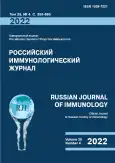Популяционный иммунитет у жителей Калининградской области к актуальным антигенным вариантам вирусов гриппа в период 2018-2021 гг.
- Авторы: Гончаров А.Г.1, Егоренкова О.А.1, Шуплецова В.В.1
-
Учреждения:
- ФГАОУ ВО «Балтийский федеральный университет имени Иммануила Канта»
- Выпуск: Том 25, № 4 (2022)
- Страницы: 419-422
- Раздел: КРАТКИЕ СООБЩЕНИЯ
- URL: https://journals.rcsi.science/1028-7221/article/view/120064
- DOI: https://doi.org/10.46235/1028-7221-1170-PII
- ID: 120064
Цитировать
Полный текст
Аннотация
В статье приведены результаты оценки популяционного иммунитета у жителей Калининградской области к актуальным антигенным вариантам вирусов гриппа в период 2018-2021 гг. Для оценки спектра циркулирующих на территории Калининградской области типов гриппа, использовался метод ПЦР в реальном времени с использованием наборов реагентов «АмплиСенс». Материалом для исследования служили мазки из рото-носоглотки, полученные от лиц, обратившихся в поликлиники с воспалительными заболеваниями верхних дыхательных путей или проходящих лечение в амбулаторных или стационарных условиях в ЛПУ Калининградской области. Для оценки гуморального иммунитета служила сыворотка крови, полученная от здоровых жителей Калининградской области, при прохождении периодических профилактических осмотров в поликлиниках города и области. Исследования проводились во всех возрастных группах. За изучаемый период 2018-2021 гг. проведено более 14000 исследований. Определение специфических антител в сыворотке крови проводилось постановкой реакции торможения гемагглютинации с использованием актуальных гриппозных диагностикумов (ООО «ППДП», Санкт-Петербург). Определение титра антител в сыворотках на уровне 1/40 и выше считалось достаточным для снижения риска заболевания по крайней мере на 50% За исследуемый период в области было лабораторно подтверждено 2165 случаев гриппа. В исследуемый период, основным штаммом, вызывающим грипп, был серотип A(H1N1) pdm, его удельный вес достигал 57,5%. Однако, наряду с A(H1N1) pdm, в эпидемический процесс внесли существенный вклад, будучи этиологической причиной гриппозной инфекции, в 2019 г. штамм A(H3N2) – 42,2%, а в 2020 г. штаммы гриппа типа B – 42,5%. На наличие антител за период 2018-2021 гг. обследовано 420 образцов сывороток крови вакцинированных и не вакцинированных лиц. Сыворотки забирались через 1-2 месяца после вакцинации и в период между подъемами заболеваемости (апрель-май). У вакцинированных лиц титр антител был протективным у 58,3-64,5%. У этой группы лиц, достаточный для поддержания иммунитета титр сохранялся и в весенне-летний период. Среди лиц, отказавшихся от вакцинации защитный титр антител в предэпидемический период отмечен у 41,2% обследованных, а в период межсезонья выявлен у 37,4% добровольцев. Таким образом, основной этиологической причиной, вызывающей грипп на территории Калининградской области в 2018-2021 гг. был штамм A(H1N1) pdm. Защитный уровень антител у привитого населения, в период предшествующий эпидемическому подъему заболеваемости, отмечался на 30% чаще, чем у не привитых лиц. Отмеченная в 2020 году высокая заболеваемость гриппом, вызванным штаммами гриппа В, по-видимому требует смены вакцинного препарата.
Полный текст
Открыть статью на сайте журналаОб авторах
А. Г. Гончаров
ФГАОУ ВО «Балтийский федеральный университет имени Иммануила Канта»
Автор, ответственный за переписку.
Email: agoncharov59@mail.ru
к.м.н., старший научный сотрудник центра иммунологии и клеточных биотехнологий
Россия, КалининградО. А. Егоренкова
ФГАОУ ВО «Балтийский федеральный университет имени Иммануила Канта»
Email: agoncharov59@mail.ru
магистрант высшей школы живых систем
Россия, КалининградВ. В. Шуплецова
ФГАОУ ВО «Балтийский федеральный университет имени Иммануила Канта»
Email: agoncharov59@mail.ru
к.б.н., старший научный сотрудник центра иммунологии и клеточных биотехнологий
Россия, КалининградСписок литературы
- Кривицкая В.З., Кузнецова Е.В., Майорова В.Г., Петрова Е.Р., Соминина А.А., Даниленко Д.М. Влияние вакцинации против гриппа на уровень специфического гуморального иммунитета здоровых лиц // Инфекция и иммунитет, 2022. Т. 12, № 1. С. 127-141. [Krivitskaya V.Z., Kuznetsova E.V., Mayorova V.G., Petrova E.R., Sominina A.A., Danilenko D.M. Influence of influenza vaccination on the level of specific humoral immunity in healthy individuals. Infektsiya i immunitet = Russian Journal of Infection and Immunity, 2022, Vol. 12, no. 1, pp. 127-141. (In Russ.)] doi: 10.15789/2220-7619-IVI-1750.
- Лиознов Д.А., Харит С.М., Ерофеева М.К., Зубкова Т.Г., Горчакова О.В., Николаенко С.Л. Оценка реактогенности и иммуногенности вакцины гриппозной четырехвалентной инактивированной субъединичной // Эпидемиология и вакцинопрофилактика, 2018. Т. 17, № 3 (100) С. 57-62. [Lioznov D.A., Kharit S.M., Erofeeva M.K., Zubkova T.G., Gorchakova O.V., Nikolaenko S.L. Evaluation of the reactogenicity and immunogenicity of the influenza quadrivalent inactivated subunit vaccine. Epidemiologiya i vaktsinoprofilaktika = Epidemiology and Vaccinal Prevention, 2018, Vol. 17, no. 3 (100), pp. 57-62. (In Russ.)]
- Смирнов В.С., Петленко С.В. Грипп и острые респираторные вирусные инфекции (характеристика, патогенез, профилактика и лечение). 3-е изд., перераб. и доп. СПб.: Гиппократ, 2019. 248 с. [Smirnov V.S., Petlenko S.V. Influenza and acute respiratory viral infections (characteristics, pathogenesis, prevention and treatment). 3rd ed., revised and enlarged]. St. Petersburg: Hippocrates, 2019. 248 p.
- de Courville C., Cadarette S.M., Wissinger E., Alvarez F.P. The economic burden of influenza among adults aged 18 to 64: A systematic literature review. Influenza Other Respir. Viruses, 2022, Vol. 16, no. 3, pp. 376-385.
- Tsybalova L.M., Stepanova L.A., Ramsay E.S., Vasin A.V. Influenza B: prospects for the development of cross-protective vaccines. Viruses, 2022, Vol. 14, no. 6, 1323. doi: 10.3390/v14061323.
Дополнительные файлы







